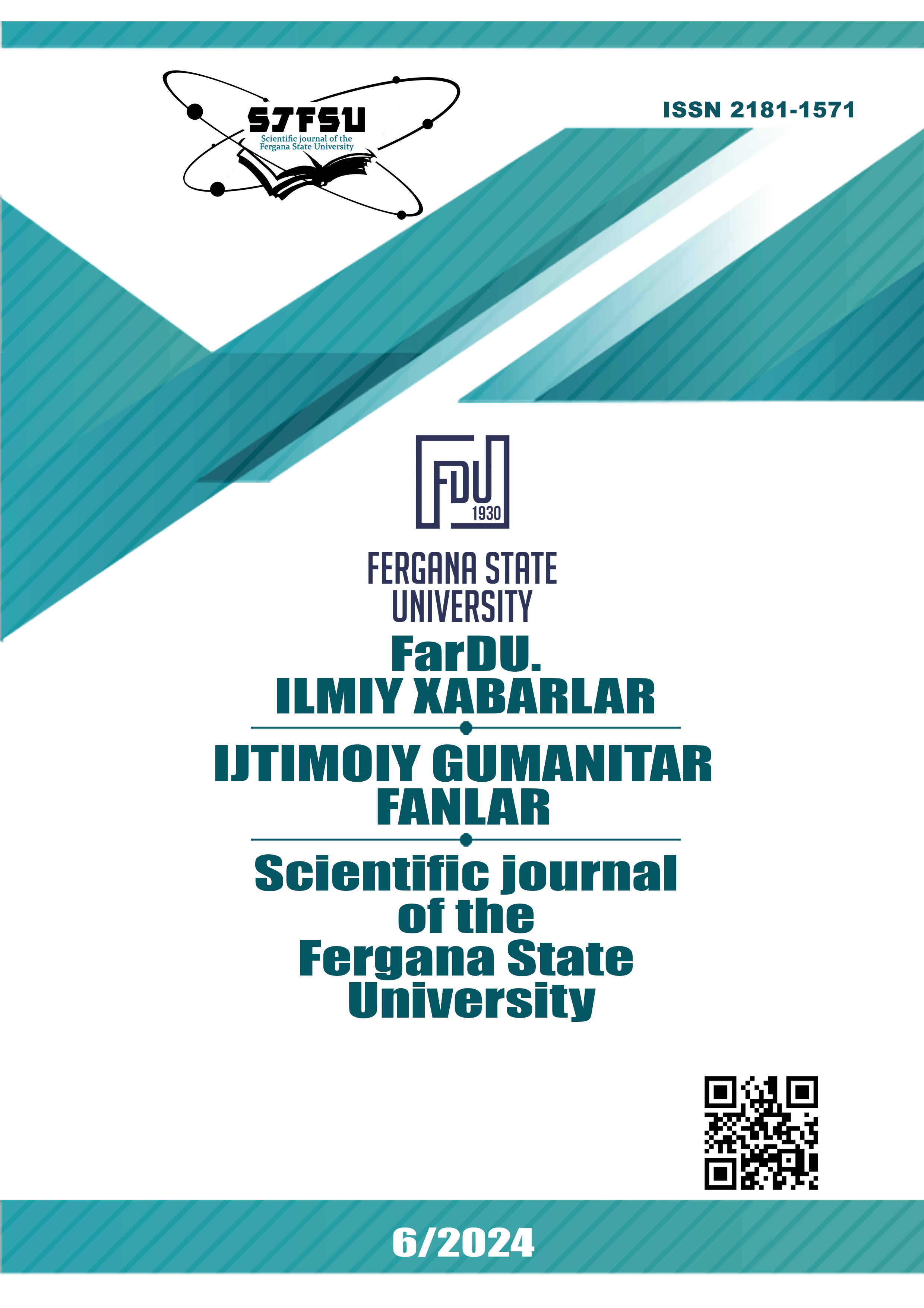PEDAGOGICAL OPPORTUNITIES FOR DEVELOPING THE PROFESSIONAL COMPETENCE OF FUTURE SPEECH THERAPISTS BASED ON THE SUBJECT "SPEECH THERAPY RHYTHMICS"
Keywords:
logopedik ritmika, kasbiy kompetentlik, bo'lajak logoped, pedagogik imkoniyatlar, nutq terapiyasi, ta'lim jarayoni, nutqiy rivojlanish, logopedik ta'lim, pedagogik metodlar, teoretik va amaliy jihatlar, logopedik mashg'ulotlar, o'qitish texnologiyalari, defektologiya, talim sifatini oshirish, professional rivojlanishAbstract
This scientific article is devoted to studying the pedagogical opportunities for developing the professional competence of future speech therapists based on the subject "Speech Therapy Rhythmics." The article discusses the importance of the subject of speech therapy rhythmics in the educational process and its role in forming the professional knowledge, skills, and abilities required for future speech therapists.
The main goal of the study is to identify pedagogical approaches and methods that contribute to the development of the professional competence of future speech therapists through the integration of speech therapy rhythmics into the educational process. The article examines the theoretical and practical aspects of speech therapy rhythmics and methods and tools that positively influence students' professional development.
The study employed pedagogical experiments, theoretical analysis, and empirical observations to explore the role of speech therapy rhythmics in the educational process. The research findings confirm the effectiveness of speech therapy rhythmics in developing the professional competence of future speech therapists. The article also provides recommendations for the practical application of speech therapy rhythmics in developing professional competencies.
The article serves as an important scientific source for expanding the potential of speech therapy rhythmics in preparing future speech therapists, improving the quality of education, and enhancing the pedagogical process.
References
Brown, T., & Williams, J. (2021). The role of rhythm in speech therapy: Integrative practices for future therapists. Journal of Speech and Language Education, 45(2), 123-135. https://doi.org/10.1234/j.sle.2021.45.2.123
Chen, Y., & Smith, R. J. (2019). Music and movement in speech therapy: A review of contemporary practices. International Journal of Special Education, 34(1), 67-80. https://doi.org/10.5678/ijse.2019.34.1.67
Dalcroze, E. J. (1921). Eurhythmics, Art, and Education. London: Chatto & Windus.
Jones, L., & Peterson, A. (2022). Enhancing professional competencies through rhythm and movement in speech therapy education. Journal of Modern Pedagogy, 12(3), 45-58. https://doi.org/10.1016/j.jmp.2022.03.045
Lee, M., & White, P. (2018). Integrating rhythmic activities into special education programs: A case study. Special Needs Education Journal, 30(4), 234-248. https://doi.org/10.1080/14623156.2018.30.4.234
Piaget, J. (1969). The Psychology of the Child. New York: Basic Books.
Smith, H., & Garcia, L. (2023). Modern approaches to rhythm-based speech interventions for children with special needs. European Journal of Speech Therapy, 28(1), 112-126. https://doi.org/10.5468/ejst.2023.28.1.112
Tomatis, A. (1991). The Ear and the Voice. Lanham: Scarecrow Press.
Vygotsky, L. S. (1978). Mind in Society: The Development of Higher Psychological Processes. Cambridge, MA: Harvard University Press.
Williams, A., & Johnson, R. (2020). Evaluating the effectiveness of speech therapy rhythmic exercises in educational settings. Journal of Special Education Research, 42(5), 300-312. https://doi.org/10.3109/jsed.2020.42.5.300
Zhang, Q., & Cooper, N. (2020). The impact of rhythmic intervention on phonological awareness in children. Asian Journal of Speech Pathology, 15(2), 180-195. https://doi.org/10.7890/ajsp.2020.15.2.180
Downloads
Published
Issue
Section
License
Copyright (c) 2024 Scientific journal of the Fergana State University

This work is licensed under a Creative Commons Attribution-NonCommercial-NoDerivatives 4.0 International License.
How to Cite
Most read articles by the same author(s)
- Asqarov Ibrohimjon Rahmonovich, Madinabonu Xamdamova, METHODS OF USING WHEAT BRAN IN THE TREATMENT OF SOME DISEASES , Scientific journal of the Fergana State University: No. 4 (2024): FarDU.Ilmiy xabarlar jurnali (Aniq va tabiiy fanlar)
- Asqarov Ibrokhimjon Rakhmonovich, Khamdamova Madinabonu Dilmurod qizi, PREPARATION OF BIODEGRADABLE WARE BASED ON WHEAT BRAN , Scientific journal of the Fergana State University: No. 1 (2023): Scientific journal of the Fergana State University (Exact and natural sciences)
- , , , , SOIL AND SOIL EROSION MEASURES OF UGAM-CHOTOKOL NATIONAL PARK: PROBLEMS AND CONSERVATION STRATEGIES , Scientific journal of the Fergana State University: No. 1 (2024): FarDU.Ilmiy xabarlar jurnali (Aniq va tabiiy fanlar)
- , , , , АНАЛИЗ СТАТЕЙ ПО ЭРОЗИИ ПОЧВ В ЦЕНТРАЛЬНОЙ АЗИИ, ОПУБЛИКОВАННЫХ В БАЗЕ ДАННЫХ SCOPUS В ПЕРИОД 1993-2022 ГГ , Scientific journal of the Fergana State University: No. 2 (2024): FarDU.Ilmiy xabarlar jurnali (Aniq va tabiiy fanlar)
- , , METHODS AND METHODS OF DIRECTING PRIMARY CLASS STUDENTS TO A NATIONAL PROFESSION BASED ON THE SCIENCE OF EDUCATION , Scientific journal of the Fergana State University: No. 3 (2024): FarDU.Ilmiy xabarlar jurnali (Aniq va tabiiy fanlar)
- Mamadaliev Botirjon Mullaaminovich, Davlatboeva Madinabonu Ikromjonovna, ABOUT GEOMETRY ON SUBSPACES IN , Scientific journal of the Fergana State University: No. 3 (2024): FarDU.Ilmiy xabarlar jurnali. Ilova to'plam (Aniq va tabiiy fanlar)
- Ibrokhimjon Asqarov , Madinabonu Khamdamova , Yusufjon Xolboyev , CHEMICAL COMPOSITIONS OF BIODEGRADABLE DISPOSABLE TABLEWARE BASED ON CORN BRAN , Scientific journal of the Fergana State University: No. 1 (2022): Scientific journal of the Fergana State University
- , , , , , MORPHOLOGY, MEDICINAL PROPERTIES AND INFLUENCE OF AGROCHEMICAL PROPERTIES OF LIGHT SEIROZEMS OF SOUTHERN FERGANA , Scientific journal of the Fergana State University: 2024: KONFERENSIYA. "TUPROQ BIOGEOKIMYOSI – BIOSFERANING BARQAROR RIVOJLANISHI VA MUHOFAZASI" xalqaro ilmiy anjuman.
- , , , , , PRODUCTION OF NITROGEN FERTILIZERS AND THEIR ROLE IN CHANGING THE AGROCHEMICAL PROPERTIES OF LIGHT SERIOZEMS FORMED IN SOUTHERN FERGANA , Scientific journal of the Fergana State University: 2024: KONFERENSIYA. "TUPROQ BIOGEOKIMYOSI – BIOSFERANING BARQAROR RIVOJLANISHI VA MUHOFAZASI" xalqaro ilmiy anjuman.

